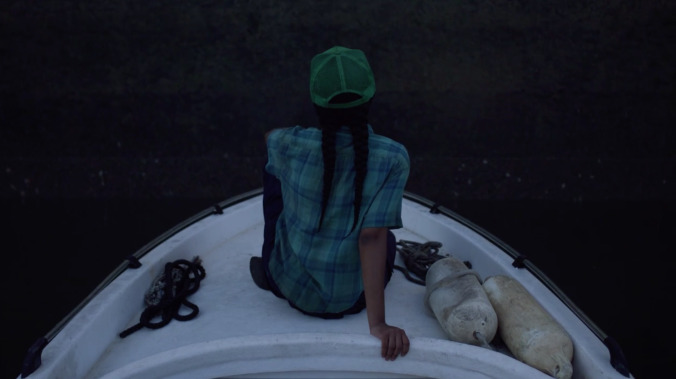Screenshot: We Are Who We Are
Episode two of We Are Who We Are retraces the steps of the pilot, situating us in Caitlin’s perspective rather than Fraser’s. Fraser becomes a background figure, an object of Caitlin’s gaze, reversing their roles.
These episodes work well in tandem: There’s a sense that Caitlin and Fraser are simultaneously trying to figure each other out while figuring themselves out. They’re both grappling with feeling like outsiders. There’s a quiet understanding between them as We Are Who We Are continues to leave a lot unsaid, underscoring the confusion and complexity of youth. It is, once again, impeccably rendered visual storytelling. And while Caitlin’s episode doesn’t run into quite as many of the perplexing character developments as the pilot, there are still problems beneath the surface of We Are Who We Are’s sun-soaked seaside wanderings.
We again hear Caitlin give the name Harper, first to an aggressive guy at an outdoor dance club where the friend group goes post-beach and then in a repeated version of the scene at the cafe. This time, we’re not lurking with Fraser. We’re right there with Harper as she flirts shyly with an Italian girl who assumes she’s an American boy. Fraser seems to be the only one who really sees Caitlin’s contemplations of gender identity, reaching out by sending her more flattering clothes to fit her aesthetic. He is, after all, quite the expert in expressive, intentional fashion.
Caitlin is very close with her father, but their relationship is distinct from Fraser and his mother Sarah’s strikingly co-dependent relationship in the pilot. Caitlin joins her father for early morning fuel runs, on which she dresses the way she wants to dress. Her relationship with her mother isn’t outright bad, but there’s a wall between them. And part of that is probably because her mother doesn’t want to be here: She fantasizes about being back in America to the extent that she follows the weather forecast in Chicago constantly, remarking that it’s 70 and sunny, a perfect day for the lake. But Caitlin can open up to her father—about Sam, the guy she’s seeing but keeps at arm’s length, and about getting her period for the first time. She also loves to spar with him. While Fraser’s episode is languid, there’s a bit more of an intensity and urgency in Caitlin’s episode, a sense that she’s unflinchingly barreling toward a target that keeps slipping just out of reach.
Caitlin and her father’s relationship is more clearly defined than the mothers-son relationships in the pilot…until the MAGA hats show up. It’s a shocking moment and little more, so the point of the shock is unclear. They can’t even wear the political hats on base, so her father says they’ll just wear them at home, suggesting he’s such an immense Trump supporter that even this behind-doors gesture means something to him. If We Are Who We Are plans on actually engaging with any of the political and social implications of this development, it hasn’t done so yet. Instead the MAGA hats are just sort of airdropped into the episode without much context or unpacking.
Similarly, the show is once again glib about the rampant nature of sexual violence in the military. While Caitlin sits reading, a couple of soldiers speak cavalierly about gang-raping a woman. Perhaps the casual placement of this obscene dialogue is meant to reflect just how pervasive and commonplace sexual violence is on the base, but when it just sort of sits there it feels like the MAGA hats—provocation devoid of meaning and examination.
We Are Who We Are remains strong in its aesthetics: The music cues incite genuine emotion. The opening shot of Caitlin’s back at the bow of a ship leaves a lasting impression. The perspective-switching for the repeated scenes is effective, offering an interplay between gazes. The ways Fraser and Caitlin want to be seen and the ways they are seen within their specific setting are often at odds with each other, and that provides a strong thematic link between the two episodes. It’s an interesting way to begin the series, unspooling two characters at once and in conversation with each other.
On the one hand, the show’s vagueness about some of its character development makes sense for a story so steeped in self-discovery and teen angst. These characters are still figuring out who they are and therefore the show is, too. But too much ambiguity in the character work makes it feel like we’re just treading water, unsure of what lies beneath.
Stray observations
- I’m continuing to use she/her pronouns for Caitlin until the show says otherwise, because all press materials for the show do so. I still have a lot of reservations about the decision to cast a cis actress in what seems to be a transmasculine or genderqueer role and will likely bring up those reservations every week, because it’s a conversation worth having over and over again since it’s a problem in film/TV that persists.
- Danny is maybe exploring religion, but we don’t get a lot on that front.
- I’m not sure if the perspectives are going to continue switching episode by episode or if the episodes are going to become more blended between Fraser and Caitlin from now on, but I do like the POV-switching framework a lot.
- Caitlin is also really close with Danny’s friend Craig, and I don’t quite understand the depth of that relationship yet, but it seems sweet.

